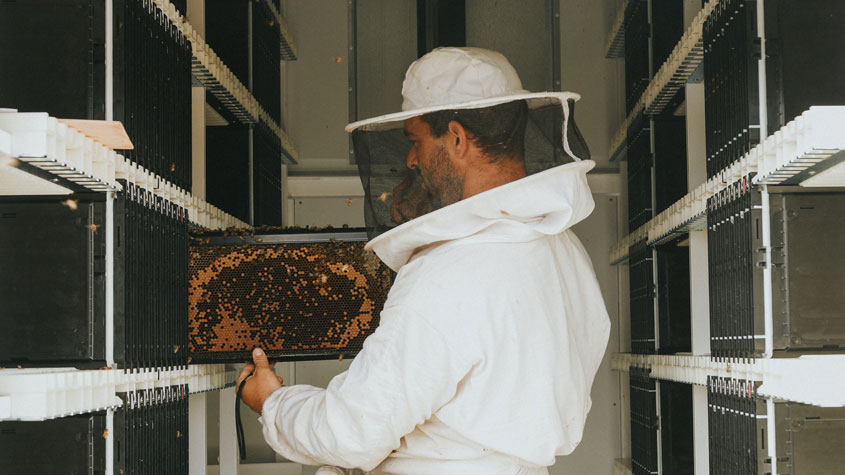
Bees are the most important pollinators in the insect world and play a central role in ensuring the global food supply. Without pollination, many plants cannot reproduce. Saar Safra, CEO of Israeli start-up Beewise, is on a mission to save bees − and at scale − using artificial intelligence (AI), computer vision and robotics. Mr. Safra explains how Beewise’s high-tech solution is helping to save the world’s bees. He also discusses the role that intellectual property (IP) plays in supporting small companies like Beewise, which are working to tackle some of the world’s most pressing challenges.
How did you come to set up Beewise?
I am an entrepreneur with a background in software engineering, but my co-founder, Elijah Radzyner, is a commercial beekeeper who, like other beekeepers around the world, has been facing the collapse of bee colonies, despite his best efforts. So, we got together and began exploring how we could use robotics and AI to save the bees. We started iterating on different products. The first ones were very rudimentary, but very early on we saw a product that could actually save bees at scale. That’s when we established Beewise and started developing our BeeHomes.
Why is it so important to save the bees?
First, bee colonies are collapsing all around the globe. This is a huge problem because bees pollinate 75 percent of all the fruit and vegetables, seeds and nuts that we eat on this planet. Without bees, we won’t have the vegetables, fruits and flowers we enjoy every day. Bees are the infrastructure of our global food supply, yet we are losing about 35 percent of bee colonies every single year all over the world. This is not about single bees dying; it’s about whole colonies of bees dying, which is a huge problem.
Second, the global population is growing and as more people come out of poverty, they want a healthy diet. So, at a time when demand for the bees’ products keeps growing, the supply is being cut by 35 percent every year. And the gap is getting wider. There is no clear line of supply keeping up with demand. This is the problem that we are trying to solve.

Why are colonies collapsing?
When you’re dealing with a specific virus, like COVID, for example, you can identify it and work towards a solution. It takes time, but it’s a relatively achievable task.
With bees, that isn’t the case. Bees are suffering from a plethora of issues, all at the same time. Take climate change. Every time temperatures rise by one-half of a percent, bees lose about 5 percent of productivity. Bees are also dealing with pests and diseases that didn’t exist a few decades ago. And with modern agriculture, they’re subject to pesticides. We use these chemicals to protect our crops, but they kill the bees as well. Together, all these stressors are creating the perfect storm for bees.
Humans have been working with bees for millennia, but with traditional wooden hives beekeepers can’t treat bees in real time - that’s the big issue. With the BeeHome we can mitigate the stressors and make it possible to treat bees in real time.
Bees are the infrastructure of our global food supply, yet we are losing about 35 percent of bee colonies every single year all over the world.
Tell us more about the BeeHome?
In very simple terms, just like traditional hives, the BeeHome houses a number of bee colonies. The BeeHome is just bigger and in its central corridor it has a robot that monitors the colonies 24/7 using computer vision, AI, and neural networks.
The robot inspects the bees, and our AI tools convert those images into data, which then identify any issues the bees may be experiencing and trigger the robot to take appropriate action. For example, if the AI sees that the bees are ill, the robot will introduce a few drops of medicine to the hive – five droplets can save an entire colony – or, if the bees don’t have water or food, the robot can replenish the colony’s supplies from within the BeeHome. It’s a very simple mechanism and allows the bees to be managed in real time. We haven’t changed traditional beekeeping in any way, we simply do it with a robot in real time.
How did you go about building the Beehome?
The idea is to take existing technology and to apply it to our purpose. We’re not trying to build state-of-the-art hardware. We integrate the simplest and most affordable off-the-shelf hardware into our software platform, which manages and orchestrates the whole solution. I call it software wrapped in tin (credit #Elon Musk). The real value is driven by the AI-driven computer vision; it identifies which treatment to administer and when.

What sort of data do you collect?
We collect a magnitude of data. A traditional hive has 60,000 cells divided into 10 frames (the honeycombs), each comprising around 6,000 cells. This is where the bees store the queen’s eggs, larvae and pupae as well as pollen nectar and honey. This is their home. The BeeHome has 30-frame colonies, with 180,000 cells in each colony, which are monitored one by one. By monitoring the colonies 24/7, we generate terabytes of data, which go off into the cloud to be analyzed by the AI, which identifies what is going on in each cell.
Identifying a disease in real time is hard because you need to monitor each cell constantly to identify any small fluctuations in the cells or the bees’ behavior which may raise a red flag and require a decision as to the appropriate course of action. That whole process is done using AI.
We haven’t changed traditional beekeeping in any way, we simply do it with a robot in real time.
These data are allowing us to save the bees on the planet, and that is directly tied to saving our global food supply. With our solution, colony collapse has fallen to less than 10 percent compared to the industry benchmark of 35 percent. And we are achieving that with a robot.
We’re also examining the data to see if there are other things we can learn from it to optimize the colony, pollination, or honey production. If we can produce these devices and deploy them quickly, we will be saving bees at scale.
These data have always existed but were hidden within a wooden box that acted more like a black box. With traditional hives, you get a momentary glimpse of what’s going on and can’t really keep track of it. With the BeeHome we are not only thinking outside of the box, we are re-inventing it. We’re tracking the data, storing it and analyzing it in the hope of learning other secrets that will be beneficial to the bees and to us – you know we are tied together.
What were the main challenges associated with developing it?
There are many challenges associated with making a harmonized device that treats bees and successfully lowers colony collapse rate. Our device combines hardware, software, biology and chemistry. After all, we are managing livestock. The bees come and go at will, and we have to provide them with a comfortable and convenient home, otherwise they will leave. The challenge has been to convert beekeeping expertise and a chaotic and complex biological system into AI and to train the models and the algorithms. Tracking and identifying 2 million bees that are flying around is not easy. But with the beekeeping expertise of my co-founder, and the company’s very powerful talent pool of technologists, we have been able to pull this together. It took a couple of years, but now we have the BeeHome, a five star hotel for bees. It’s made of tin, is thermo-regulated and keeps bees safe from storms and fires. It’s beautiful.
How are beekeepers benefitting?
Beekeepers have a new platform to manage their business. Our beekeeper customers typically own 10,000 traditional hives, with 10,000 colonies and generate revenue from pollination and honey. They typically get to check their hives and treat the bees once a month at best. Our solution enables them to see what’s going on in their hives 24/7. We offer them a better tool to manage their business and give the bees better tools to cope with modern-day stresses. It’s a win-win-win.
Feedback from our beekeeper clients is allowing us to continue to improve our platform. We iterate constantly, and the BeeHome is getting better all the time. For example, the BeeHome’s in-built honey harvester used to take 19 minutes to harvest the honey from our boxes; now it only takes 15 minutes. That said, while beekeepers are our paying customers, the bees are our primary focus.
What has been the uptake?
People are both baffled and excited by our solution. There is certainly an important education component in the market. When you’re introducing a disruptive technology, you often have to train people to think differently about the problem and the solution. Our customers are really hurting because they are losing 35 percent of their revenue-generating assets – their bees – every year, despite their best efforts. This is a powerful solution for them.
What role does IP play in the company?
We started patenting our solution early on because we realized we are the first on the planet to use robotics in a beehive. We have secured 18 patents and there are more to come. We’re happy about that. Our IP rights will certainly slow down people who try to copy what we do. Our AI, neural networks and datasets, which took nearly four years to develop and optimize, and which are now 99.9 percent accurate, are also important moats that will keep us ahead.
Would you like to see the IP system change?
I have been filing for patents since 1997. It’s a slow and cumbersome process and standards for the enforcement of IP rights fluctuate around the world. Cost is also a barrier for many small companies. Patenting is an expensive proposition, and there is not always an immediate and tangible return on investment.
I think the IP system needs significant investment to make it more responsive and efficient, and there needs to be better enforcement of rights. I want it to cost more to infringe IP rights than it does to respect them.
Why is it important for companies like Beewise to have an eye on IP?
We are first to market, we are first on the planet and we are dealing with a huge problem. We’re still a small company, so we don’t feel huge pressure from competition, but when you bring an innovation to the world and want to leverage it from a business standpoint, and have so much to gain or lose, you want to make sure that you are protected. Without IP, you are vulnerable to competitors.
What are your plans for the future?
Saving the bees is no small feat. We have a big mission ahead of us. I want to arrive at a point in time when bee colonies are no longer under threat. The collapse of bee colonies is a derivative of climate change; we’re causing this harm and, paradoxically, we’re harming our own global food supply. I still have some way to go to make this work, and if I succeed, I will have a good sense of accomplishment and then I’ll go tackle a bigger problem.
You have set up a number of companies. What has been the secret of your success?
Many factors, but the common thread is luck. The second thing is failure. You have to accept that you are going to fail. We are building the first device that does what it does on the planet. Nobody has ever done this before. What are the odds that the first device that we build will work as planned? Zero. I guess failure is also part of success, right? I mean, you can’t get to success without going through failure – it’s on the same path. But it’s really hard, and most don’t necessarily understand its value.